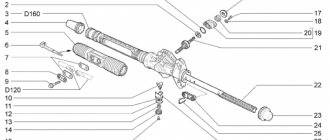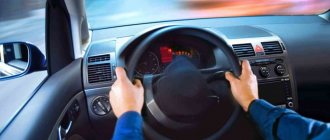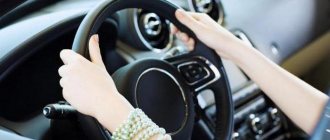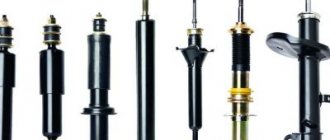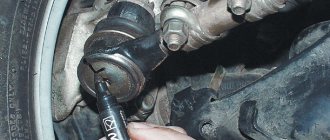This article discusses the main reasons why clicks are heard when turning the steering wheel. Describes how to diagnose and solve this problem.
Author: Raul_ HF and wheel alignment mechanic; experience – 3 years. Service/repair consultant at Toyota DC; experience – 4 years.
Normal operation of the steering system should not be accompanied by extraneous sounds, such as knocking or clicking noises when turning the steering wheel. The appearance of such symptoms indicates the likelihood of wear of components of one of the most important active safety systems of the car, or other components of the chassis that are driven along with the rotation of the steering wheel.
Possible causes of extraneous sounds when turning the steering wheel:
- wear of the steering rack drive shaft cardan crosspieces
- play in the splined connection of the rack drive shaft
- wear of the steering rack supports
- biting the steering rack rod
- radial play of the steering column shaft
- moisture ingress and corrosion of the lower ball joint
- wheel drive grenade malfunction
- violation of the integrity of the spring
Wear of crosspieces of cardan joints of rack drive shaft
If you hear clicks when turning the steering wheel, which can also be felt on the steering wheel, you should check the condition of the steering drive elements. The wear of the crosspieces is detected by probing the universal joint when turning the steering wheel to the right and left at a small angle.
The bite is clearly felt by the hand and allows you to accurately identify the worn part. It is necessary to take into account that there are several such parts and some may be located in hard-to-reach places. In some cases, it may be necessary to dismantle components to disassemble and inspect components, followed by replacement of the faulty part.
Rumble (steering wheel turns, car stops)
Typically, this sound is produced by the hydraulic booster, which is installed on many cars. And there is nothing scary about this noise. When you get into the car, you may feel this sound - now you know that it will appear regularly. It is extremely rare that such a sound is detected when the steering wheel is turned in only one direction.
It seems that you have become accustomed to this sound, the car has been used for a long time, but the hum becomes louder and more distinct - now it can be heard not only when turning the steering wheel in the absence of movement, but also while driving. Here, be sure to try diagnosing the power steering. The most common cause of such noise is a lack of special power steering fluid, so the problem is often solved when such fluid is added to the power steering reservoir located under the hood (it is marked with MIN and MAX marks, they mean the maximum and minimum amount of fluid). Obviously, at the MIN level, fluid is most likely leaking from the system, so after topping up, you will need to check this level for some time (at least once a week).
The noise may also be caused by a breakdown of the power steering pump, weak tension of the power steering belt, as well as air flow that has penetrated into the power steering circuit. Alas, in all these cases you should definitely contact a car repair shop.
As a rule, problems with power steering are almost always accompanied by the need to apply more force than usual to turn the steering wheel.
Play in spline joints
Play in the splined connections of the rack drive shaft is detected in a similar way. In some cases, the so-called “bleeding” of the shaft can help. To do this, you need to loosen the fastening bolt and move the shaft several times along the splines, then tighten it again. There is a possibility that the splines, as a result of wear, have lost effective engagement and, as a result of such a procedure, will come into more intimate contact, and the free play in the connection will be eliminated for some period of time. If bleeding does not help, change the spline shaft.
Non-standard cases
It may not be the suspension or steering parts that are knocking. Shocks and body pecks lead to the movement of units. If they “sit” loosely and there is metal-to-metal contact, clinking cannot be avoided.
- Single dull knock when starting off. See rubber-metal engine or gearbox mounts, transmission driveshaft. For example, when starting, the motor may tilt and hit the spar.
- Rattling on small bumps and in turns. Listen to see if there is a knocking sound in the steering wheel when braking; if there is, the brake caliper guides are worn out.
- Intermittent impact sound, more common when turning at low speeds. Malfunction in the differential of a front-wheel drive vehicle.
Tighten the key bolts and nuts more often, refuel only at gas stations with high-quality gasoline, and remember: a worn CV joint does not knock, but crunches, and does this with the wheels turned out.
Worn steering rack supports
During the operation of the car, not only the steering rack mechanism, which takes up the load with each turn of the wheels, wears out, but also the rubber fasteners, through which the unit is fixed to the body or subframe, are subject to wear, destruction and loss of elastic properties. In this case, when you turn the steering wheel in place, you will feel characteristic knocks or clicks, indicating that the rack body is moving freely. The larger it is, the stronger the sound will be under load. Wear is detected by monitoring the position of the unit when the steering wheel is turned left and right. At the same time, the movement of her body will be clearly noticeable. The solution is to either seal the clamps by placing a layer of rubber under them, or immediately replace worn-out rubber bands with new ones.
Anti-roll bar bracket and bushings
The stabilizer may knock in broken bushings at the place where it is attached to the lower arm or to the side member (VAZ classic).
The first thing to do is to conduct an external inspection of the bushings; if they are burst in one or more places, as shown below, then they need to be changed and most likely they are the source of the knocking or squeaking noise.
To verify your assumptions, grab the stabilizer rod in the bushing area with your hand and, with sharp movements, forcefully pull it down and release it.
If you hear a creaking or knocking noise, it means the bushing is partially or completely worn out.
To finally make sure that the latter is worn out, grab it with both hands in the same place as before, and with force, sharply pull the rod in different directions. The appearance of a knock in the bushing will confirm your assumptions.
The other side of the rod is checked in the same way.
On the VAZ 2110/2112 and other models, in addition to the stabilizers themselves, brackets are structurally provided, in common parlance “eggs”.
Their bushings are also checked for integrity by external inspection and under load, and replaced if necessary.
Biting the steering rack rod
Biting the steering wheel when rotating indicates damage to the rod due to corrosion as a result of moisture getting inside the body. Typically, biting appears when the steering wheel is turned to a certain angle or number of revolutions. When a rusty section of the rod passes through the plastic guide bushing, strong friction occurs, since the surface of the rod is no longer mirror-smooth, but rough. This is accompanied by a characteristic creaking or clicking sound when turning the steering wheel. The unit must be disassembled and inspected for parts damaged by corrosion, followed by their replacement. In advanced cases, the entire rack will need to be replaced.
Broken strut spring
Often the cause of extraneous sounds is a spring that has burst as a result of metal fatigue. A failed spring can be easily identified by inspection. The elastic suspension element should be replaced in pairs with the opposite one to avoid body distortion. A broken coil can touch the body or other parts, producing grinding and clicking noises when turning the steering wheel.
Good day to all. The problem is that when turning the steering wheel there are loud clicks in the area of the right wheel. I have had pumps, ends, ball bearings and bearings changed in 4 services. The result is zero. The masters just shrug their shoulders, saying that this is the first time we’ve seen this and what the reason is, no one can say; we’ve already spent a fair amount of money, but the problem remains. Has anyone had a similar case?
I've already replaced 2 pieces in a month.
by Adminrive · Published 03/06/2015
In the region of 1900-2200 rpm there is a dip
by Adminrive · Published 04/11/2015
Steering column shaft play
Clicks in the steering column usually appear while the car is moving and indicate the presence of radial play in the shaft as a result of bearing wear. Backlash is diagnosed simply - just reach the shaft with your hand and try to swing it relative to the axis of rotation. If a malfunction is confirmed, repair of the steering column is possible on some cars; on other models, only replacement of the entire assembly is possible.
The malfunction is not critical and, apart from an unpleasant knock, will not cause any other consequences for some time.
Additional symptoms
Causes of clicks in the steering column
As we see, there can be many reasons for clicks in the steering wheel. Suspicious symptoms may include the hum of wheels, tapping, ringing, crackling, etc. In addition, it is always necessary to monitor the behavior of the car itself. If there is one breakdown or another, the car will not behave as usual on the road. If the tip or bushing breaks, the car may “wobble” while driving. If the CV joint is faulty, the clicking will increase over time to an unpleasant grinding sound. The car will always show what is wrong with it.
Corrosion damage to the lower ball joint
A rusty lower ball joint, which bears a significant load, can produce characteristic clicks and a fairly loud squeak when turning. The reason is mechanical damage to the boot and moisture ingress, which leads to leaching of the lubricant. In addition to the creaking, there is usually already some play in the connection, formed as a result of friction of the rusty ball against the plastic seal. As a result of the play, a clearly audible knocking sound occurs when driving over uneven surfaces. A ball joint damaged by corrosion must be replaced.
Quiet in place: knocking only when turning the steering wheel while driving
If it is not a cardan shaft, a rack, or the consequences of flushing the internal combustion engine with dimexide, feel free to inspect the suspension. Anything can tap:
- Racks.
- Support bearings.
- Ball joints.
- Anti-roll bar.
- Wheel bearings.
Most parts are checked with the vehicle stationary:
- "Supports". Ask an assistant to turn the steering wheel while you put your hand on either the strut rod or the spring. Extraneous crunches and play indicate bearing failure.
- "Ball" Drive the car onto a lift, pit, or overpass and swing the lever on which the support is fixed using a pry bar. There should be no tapping.
- Shock absorbers. Place your finger on the strut rod and swing the car up and down by the wing. The knocking sound most often occurs due to a decrease in pressure in the strut due to a worn oil seal or scuffing on the rod. After a while it starts to flow. If you have already removed the shock absorber, make sure the diagnosis is correct - tug on the rod to see if it is loose or not. When installing a new one, make it a rule to bleed it, otherwise clunking will soon occur.
What to do with a humming bearing?
The first question that arises after detecting a malfunction is whether it is possible to continue driving. Motorists are forced to postpone repairs by various circumstances: an urgent trip, lack of free time for replacement and a simple lack of funds. Some individuals hope for the Russian “maybe” and continue to operate the car to the last degree of wear and tear.
The final failure of the bearing of any of the front wheels is dangerous primarily for the passengers of the car. If the separator falls apart, a huge play will appear in the hub, the wheel will begin to wobble and the car will lose control. It is difficult to predict how this will end when driving at high speed. The destruction of the rear bearing assembly is not so critical - the malfunction will simply immobilize the car.
Such breakdowns often lead to the separation of the front or rear wheel, which flies further due to inertia. There is enough video material on the Internet showing where detached car ramps end up - in oncoming traffic, pedestrians, and so on. If the owner of the wheel remains unharmed in an accident, it can cause damage and injury to others.
What to do when a bearing hums:
- Perform the diagnosis yourself without delaying it. Find out exactly which side the problem part is on.
- The front wheel bearing, which produces a characteristic noise, is strongly recommended to be replaced immediately.
- If you need to get to the garage after discovering a problem, drive slowly and carefully. Stopping periodically, check the degree of heating of the hub and allow it to cool down.
- There is also no need to delay with a faulty rear mechanism. Allow time to replace the part and, if necessary, find funds or park the car until repairs are made.
It is considered incorrect to ask how long you can drive with a humming wheel bearing. No auto mechanic in his right mind will give a definite answer, since such driving is akin to a lottery. Practical experience shows that most drivers do not want to take risks and take the situation to an extreme, and therefore change the non-working part in a timely manner.
After I published an article about identifying a CV joint failure, questions about other components started pouring into my blog. Namely, how to determine this or that malfunction. And now several people are asking a question about the wheel bearing, namely how to understand that it is faulty. Today I will also try to explain simply and clearly how to identify a breakdown with your own hands...
CONTENTS OF THE ARTICLE
The wheel bearing is a very important element; without it, the car wheel would not spin. It experiences really high loads, and therefore must be made of wear-resistant, high-quality materials. However, over time, due to high mileage or simply improper use of the car, this part can fail. It is a MUST to change it, otherwise you can provoke a big accident.

